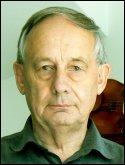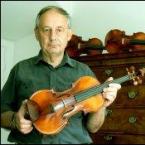Born in New Zealand in 1939, the son of a violinist, Nigel Harris learned to play the piano and violin as a child, but a strong interest in building things led him to read civil engineering at university. When a partner in a firm of architects and engineers he continued to play the violin as an amateur and soon developed a deep interest in the instrument itself. His work involved analysing the forces, stresses and movements of multi-storied building structures under earthquake vibrations. He was in the rare position to see how these techniques could be used to analyse violins, to find the forces stresses and movements caused by sound vibrations. His study unlocked many of the reasons why the violin is the shape it is, in outline and in plate arching and the relationship between the front and back shape.
To continue the research it became necessary to make some violins. After making several violins, Nigel travelled to Italy where he made a thorough study of the Italian varnish tradition. In 1981 Nigel became a full time violinmaker, and devoted his workshop to the making of new instruments only. Nigel left New Zealand in 1984 and set up his family home and workshop in England and now lives and works in London. To further his research Nigel did a PhD at the Institute of Sound and Vibration Research at Southampton University. His thesis was on the relationship between the shape of the arching curves of violin plates and the tone of the instrument. In 1994 Dr. Harris was joined by Roger Sheldon.
Born in New Zealand in 1939, the son of a violinist, Nigel Harris learned to play the piano and violin as a child, but a strong interest in building things led him to read civil engineering at university. When a partner in a firm of architects and engineers he continued to play the violin as an amateur and soon developed a deep interest in the instrument itself. His work involved analysing the forces, stresses and movements of multi-storied build...





 Harris,Nigel
Harris,Nigel

